
Flies are insects of the order Diptera, the name being derived from the Greek δι- di- "two", and πτερόν pteron "wing". Insects of this order use only a single pair of wings to fly, the hindwings having evolved into advanced mechanosensory organs known as halteres, which act as high-speed sensors of rotational movement and allow dipterans to perform advanced aerobatics. Diptera is a large order containing an estimated 1,000,000 species including horse-flies, crane flies, hoverflies, mosquitoes and others, although only about 125,000 species have been described.

A crane fly is any member of the dipteran superfamily Tipuloidea, which contains the living families Cylindrotomidae, Limoniidae, Pediciidae and Tipulidae, as well as several extinct families. "Winter crane flies", members of the family Trichoceridae, are sufficiently different from the typical crane flies of Tipuloidea to be excluded from the superfamily Tipuloidea, and are placed as their sister group within Tipulomorpha.

The Asilidae are the robber fly family, also called assassin flies. They are powerfully built, bristly flies with a short, stout proboscis enclosing the sharp, sucking hypopharynx. The name "robber flies" reflects their expert predatory habits; they feed mainly or exclusively on other insects and, as a rule, they wait in ambush and catch their prey in flight.

Choerades is a genus of robber flies described by Francis Walker in 1851, belonging to the family Asilidae, subfamily Laphriinae.
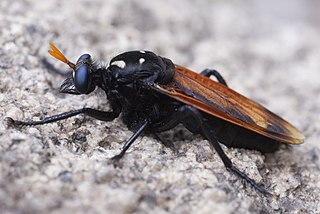
Prolepsis is an insect genus of mainly neotropical Diptera in the family Asilidae or robber flies.

Efferia is an insect genus of mainly neotropical and nearctic Diptera in the family Asilidae or robber flies. It is one of the most species-rich genera of Asilidae, with particularly high diversity in arid or semi-arid ecosystems of the New World.

Diogmites is a genus of mainly neotropical flies in the family Asilidae or robber flies.

Neoitamus cyanurus, the common awl robberfly, is a species of 'robber fly' belonging to the family Asilidae.

Neoitamus melanopogon, commonly known by the name common robber fly, is a species of fly of Asilidae in the genus Neoitamus, found in both the principal islands of New Zealand.
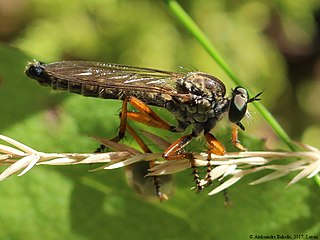
Neomochtherus pallipes, the Devon red-legged robber fly, is a species of robber fly in the family Asilidae.

Mallophora bomboides, also known as the Florida bee killer, is a predaceous species of robber fly of the family Asilidae that feeds primarily on bumblebees. M. bomboides is a noteworthy instance of Batesian mimicry given its close resemblance to its prey, the bumblebee. These bees are typically found in the Eastern and Southern regions of the United States like South Carolina and Florida.
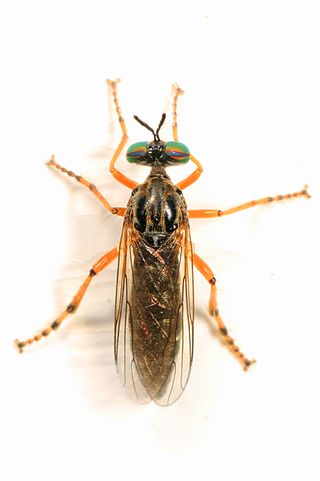
Taracticus is a genus of robber flies in the family Asilidae. There are about 16 described species in Taracticus.
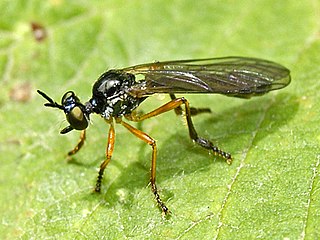
Dioctria bicincta is a species of robber fly classified in the subfamily Dasypogoninae of the family Asilidae.
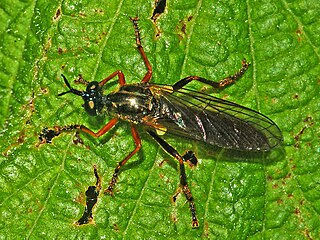
Dioctria rufipes, the common red-legged robberfly, is a species of robber fly in the subfamily Dasypogoninae of the family Asilidae.

Cyrtopogon ruficornis is a species of fly in the robber flies family. It is found in parts of Central and Southern Europe.

Stilpnogaster aemula is a species of 'stiletto flies' belonging to the family Asilidae.

Machimus setibarbus is a species of fly in the family Asilidae, the robber flies and assassin flies.

Cerdistus erythrurus is a species of robber fly in the subfamily Asilinae. It is the type species of the genus Cerdistus.

Choerades marginata is a species of robber fly found in Europe.
Mallophora ruficauda is a species of parasitic robber fly in the family Asilidae, endemic to South and Central America. Like other robber flies, M. ruficauda is known for its aggressive behavior and predation upon other insects, especially bees. M. ruficauda mimics a bumblebee to fool predators into thinking it has a painful sting and is not worth eating.























